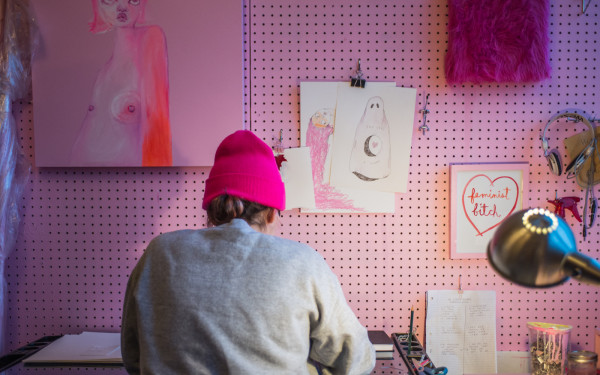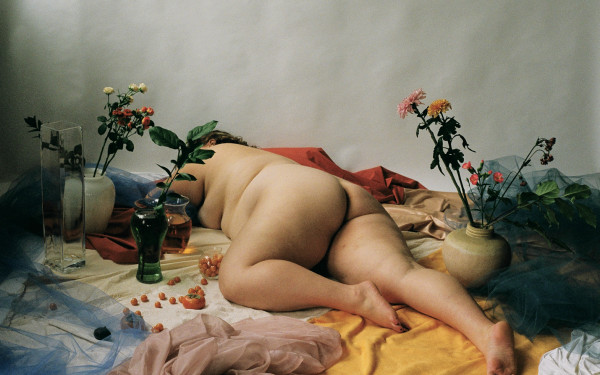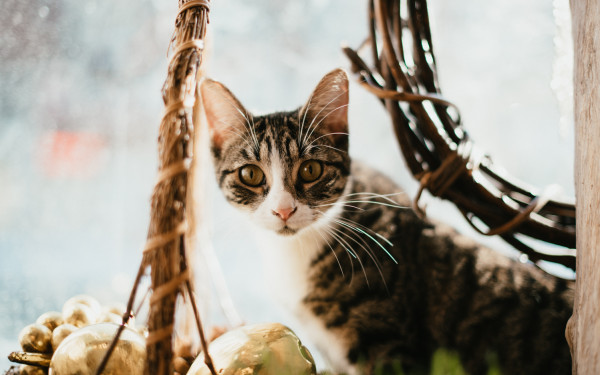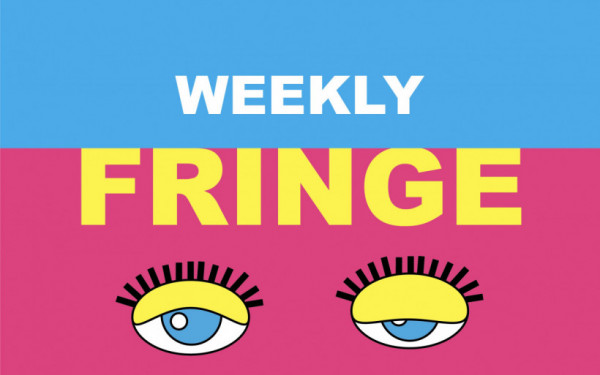Meet Callen Schaub, the Artist Known for His Colourful and Creative Drip Paintings
Learn About Schaub’s Unique Style and Technique of Painting That Place Him in a Category All of His Own
Callen Schaub is not the first artist to employ a technique known as drip painting; what makes him special is how he goes about doing it.
One part artist, one part scientist, one part visionary, the painter makes his own troughs and contraptions from found materials to drip paint onto a variety of unconventional canvases. Drip painting is a discipline situated within the practice of abstractism, a movement that really took off in the 1940s.
The Canadian artist, who is based in Montreal and Toronto, can be categorized by his unusual approach to art, from the mediums he uses, the application and colour palette. Usually beginning with a more solid background of black, white, or minimal mix of colours spun onto one of his many unorthodox canvases, such as a heart, 3D metal sphere, or even people.
When Schaub started this process, he began with just a potter’s wheel to pour, drip and allow the paint to flow. As his commitment and love for this form grew, he began to craft his own tools for this almost scientific, artistic process, which includes harmonographs as well as pendulums in order to get the perfect swing to pour the paint fluidly onto the canvas.
Schaub said he’s always been an artistic individual. Taking to the streets as a graffiti artist to work on his craft, he said he wasn’t thinking of professional ends. Drawing inspiration from artists like Banksy, Schaub started his journey with spin paintings, using them as backgrounds,with stencils over top.
There were meditating monks, and visual representations of the viewer immersed in the painting. “I realized that the figure in the work was actually, literally, the person viewing it, so if I could immerse the viewer into the work, then I don’t have to literally put the person into the work.”
Using the stencil-background format, there was a sense of chaos meeting calm throughout his pieces. “I realized I was relying on the stencil bringing the emotion,” explained Schaub. He said this led to him moving away from graffiti art and towards abstraction.
The next challenge was to immerse the viewer into his work, without literally incorporating them inside. His current style achieves this on two different levels: the first being the evolution of his artistic style, and the second being the live aspect that has gone on to characterize his work.
The technical side of the artistic skills Schaub learned while doing graffiti didn’t translate into his graduation towards abstraction, he said. What stayed consistent throughout each medium was the ambition.
“The ambition is large. Whether painting a mural, or doing a large canvas,” he explained.
“Inspiration in and of itself is an inspiration,” said Schaub. People who derive motivation from Schaub’s work, whether artistically or personally, inspire him to paint more. The passion he has for his work is translated through each aspect, and step of the process—building his own contraptions, mixing his own colours, performing live and constantly challenging himself as an artist.

The inspiration that people draw from his work then inspires him; it is self referential. As an abstract artist Schaub has clear ideas, and images of pieces he’d like to do, or ways he wants them to turn out, but he said he tries to let his preconceptions go when painting.
“If I approach a canvas with a preconceived notion of what I want it to be then that often limits me to a very narrow avenue of expression, and very low success rate. Whatever I try, it will never look like what it looks like in my mind,” explained Schaub.
Schaub has faced criticism for his abstract style, which some view as lacking in the technical skill of a realist painter.
“A lot of it happens in the moment. People criticize that because they think it’s just [intuitive], what colour [I choose], but I think there’s something deeper there, trying to tap into a natural state of creating.” Schaub compares creating to an out of body experience. “Instead of being so in my head, I’m in my body. Not even in my body, I dissociate, almost I’m watching myself paint, having an out of body experience.”
He described it as a very natural phenomenon. The shapes movement are so prevalent in his work, pendulums, spheres, harmonographs, are shapes, forms, and expressions you can find entrenched in the natural world.
“Nature’s the greatest sculpture of all. There’s some things that are innately true and satisfying about the natural forms that I’m chasing. It’s kind of like science at play, I’m not well versed in these things, but there’s undertones of these psychics and stuff like that, that I’m referencing, but not intentionally,” explained Schaub.
The use of colour has played a large role in Schaub’s artistic practice. “Colour is emotion,” explained Schaub. In life, or in terms of colour, Schaub thinks that you need the highs to appreciate lows and vice versa. To be able to appreciate the brightest or lightest pigmentation of a colour, it needs to be informed by a dark one.
“I think it’s important to use all the colours and not play favourites. […] I’ll put down literally the entire rainbow.”
A running theme throughout Schaub’s work is the immediate moment experience; the movement of the pendulum, pouring the paint, the emotions it brings forth; it is not about the final, monetizable snapshot. “[Colour] informs our experience more than we realize,” Schaub observed.
“I don’t think I was fully prepared to talk about it emotionally. I didn’t really understand it,” said Schaub explaining his relationship with colour. While completing a BFA in drawing and painting at the Ontario College of Art and Design, Schaub shied away from using colour due to a seriousness that was imposed on him throughout the school system.
“I think it’s important to use all the colours and not play favourites. […] I’ll put down literally the entire rainbow.” — Callen Schaub
“With minimal colours I could talk about the movement, the moment. I didn’t want to get distracted with colour, cause that’s a whole other thesis.” As Schaub began to work with colour and understand it more, he said he began being able to work and speak about it more freely.
His art is pure abstraction, sometimes purposely left up to interpretation. “It’s a literal mirror. Whatever they wanna fill the void with, that’s what it means for [the viewer],” said Schaub.
The way he effortlessly mixes a multitude of colours, deftly, swiftly and without brushes is something the artist hopes people might see as evoking the same sensation they have when witnessing natural beauty—such as a sunset, the ocean, mountains, and stars. Schaub hopes that people who view his work can incorporate the same ease into their daily lives.
“That’s the feeling I’m sort of going for, that natural phenomena. When you’re looking at the ocean and the stars, there’s a sense of scale, your place in the universe, and in your life,” Schaub said.
The evolution of Schaub’s work has not been limited to unique methods of pouring the paint, he also experiments with unconventional canvases.
One such “canvas” is his partner and fellow artist Veronika Radolovich. The two have a joint series on Instagram they created together called @moon.magic.loves.you. This account features the two artist working in tandem, incorporating dance, movement, and the human form as a live paintbrush, bringing two collaborative forces together.
“I wanted to experiment and challenge myself. I think that’s the responsibility of an artist, especially an abstract artist, to keep on pushing the boundary.” Schaub has not let any medium, form, or even colour impede on his artist journey.
Constantly pushing forward and experimenting has allowed him to come up with unique contraptions, such as the harmonographs he uses in his work. It has also allowed him and Radolovich to explore new, creative, and sometimes even interactive forms to work with. “It’s really about the flow of paint,” Schaub noted.
“The first time I did a spin painting with the contraption I made, it was filmed, actually. I met this guy on the subway, he came to my studio, he filmed it. I hadn’t even seen it yet. There’s something innately voyeuristic about it, it’s mesmerizing.”
Though there is a final snapshot, the end result, that is not the most important part for Schaub. For him, it’s truly about the collaborative shared experience between him and the viewer.
“It’s because it’s other people’s experience. Breaking that barrier of separation between me and the viewer,” he said. “That interaction is very precious.”
Instagram has been very influential to Schaub’s practice, serving as a secondary art form, and an online gallery of sorts. “For me it’s very much a part of my brand. I think it’s the best gallery in the world,” he said.
For someone who derives so much inspiration and emotion from an audience, an online gallery of all of your work provides a constant unwavering audience. Schaub explained that his relationship to online feedback has evolved to the point where he sees it as someone simply experiencing an emotion. Schaub and his partner Radolovich’s collaborative pieces always happen on the full moon of every month before being posted on their joint Instagram account.It began with a dream of Radolovich’s. “I had this unfulfilled idea and fantasy of becoming a paint brush,” she explained. The two began following each other. Radolovich reached out to Schaub about her idea. They fell in love, and began the new interactive series together, making their story sound like a modern day fairy tale.
The two share a scrapbook where they document their ideas, and are slowly working their way through the book.
“We tried to bring it down to its simplest form. We found that movement works best when trying to leave marks on the canvas dancing. Our first body paintbrush piece we did, I was doing stars, and it was like this weird pukey colour. Our first trials were not so successful,” said Radolovich.
Working through a trial and error process, the two began to experience more success, and are hoping to put together a live performance in the future. Though it can be challenging for two artists with their own visions to work together, art is important to the two of them, and their relationship. Schaub explained that, “In a way it’s the biggest compliment to be able to collaborate with somebody.”
Rain or shine, sickness or health, the two artists always come together to produce something magical on the full moon. Schaub said, “That’s how the relationship is also an art form in itself. It’s not just like we fell in love, our love is built on top of our art. ”

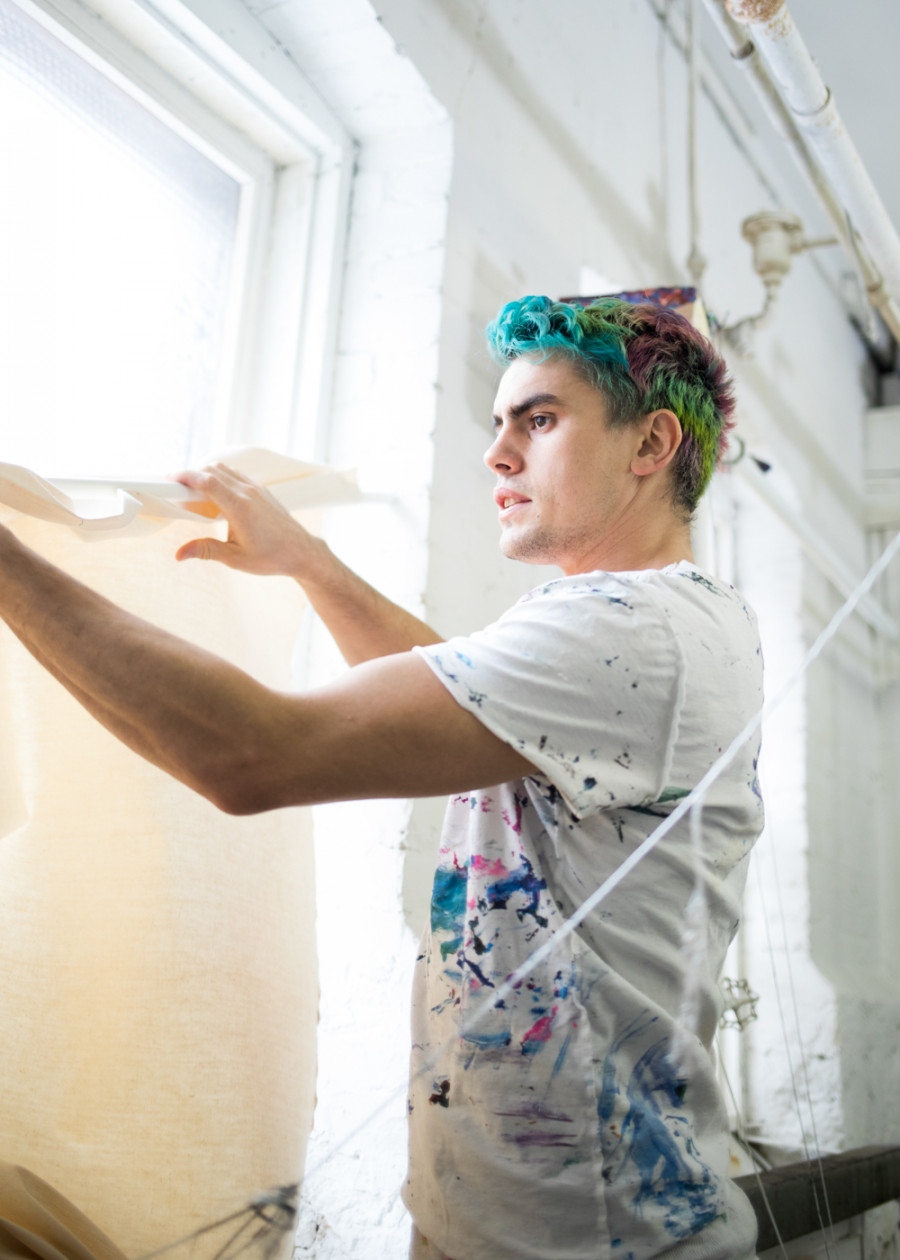
_600_832_s.png)

